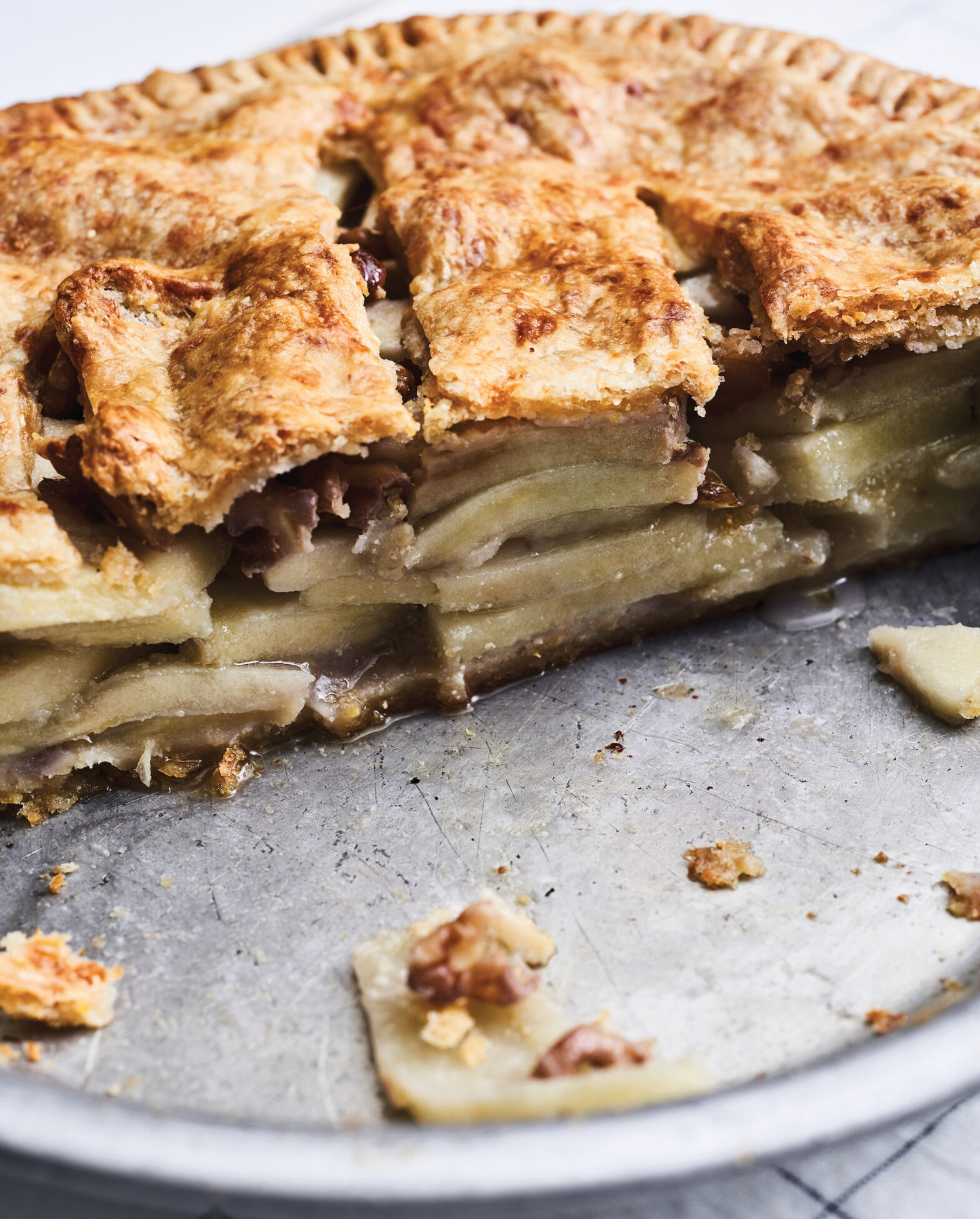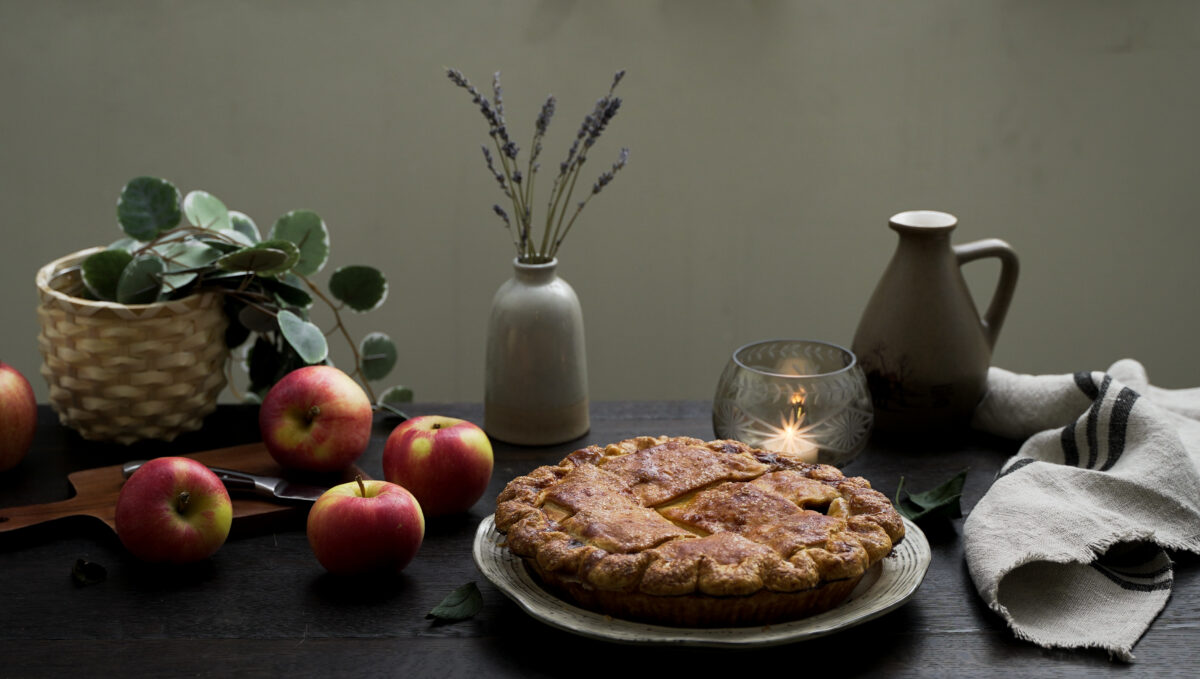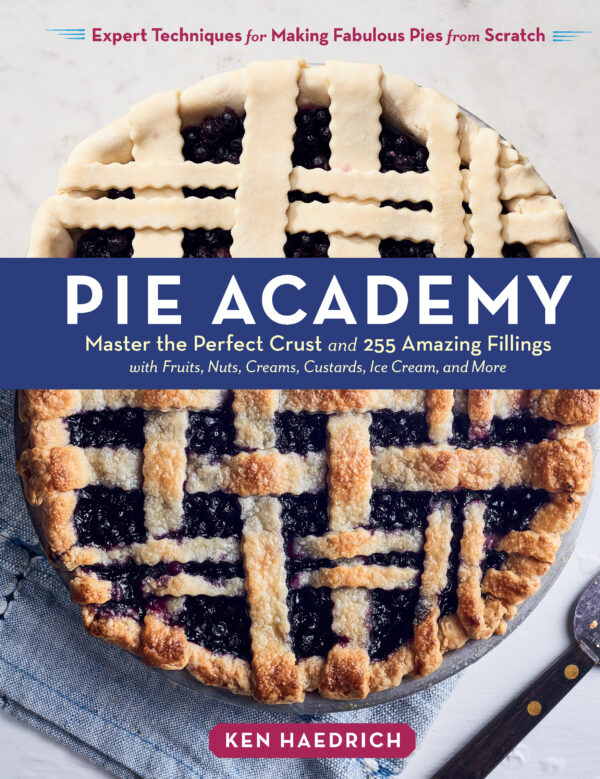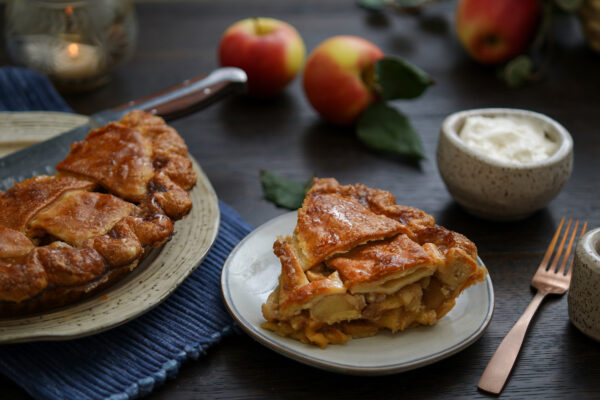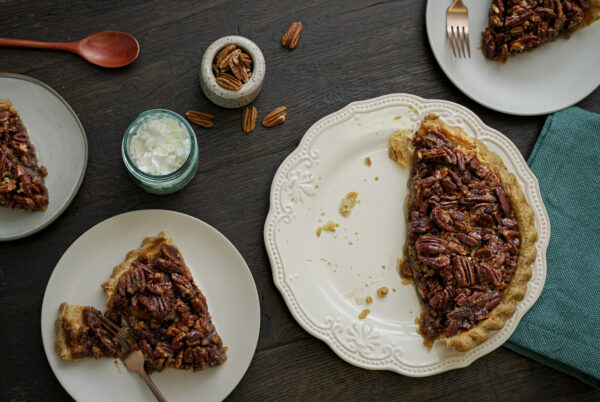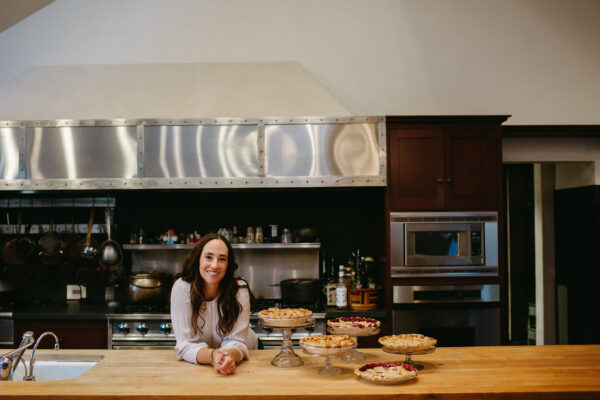New Englanders have known the pleasures of combining apple pie and Cheddar cheese for a very long time — long enough to be quite opinionated about how the two should be eaten together. Some cooks include grated Cheddar in the filling itself. Others grate the cheese over the top of the pie, which is fine when the pie is warm but less so when it is cool and the cheese hardens. Old-timers lay a slab of Cheddar right on top of their pie slice and dig in. I wanted to integrate the cheese into the pie itself, so I baked grated cheese into the crust, which keeps the snappy Cheddar flavor front and center. This is one good pie.
Makes 8 servings
Cheddar Cheese Pie Dough (see below)
Filling
8 cups peeled, cored, and sliced Granny Smith or other apples
½ cup sugar
2 tablespoons lemon juice
¾ cup chopped walnut halves, preferably toasted
2½–3 tablespoons all-purpose flour
1 egg beaten with 1 tablespoon milk, for glaze
1. Prepare and refrigerate the pie dough. Roll the larger dough portion into a 121/2- to 13-inch circle and line a 9- to 91/2-inch deep-dish pie pan with it, letting the overhang drape over the edge. Refrigerate the shell until needed.
2. Combine the apples, sugar, lemon juice, and walnuts in a large bowl. Mix well. Let stand for 5 to 10 minutes.
3. Adjust the oven racks so one is in the lower position and another is in the middle of the oven. Preheat the oven to 400°F (200°C). Line a baking sheet with parchment paper.
4. Sprinkle the flour over the apples, using the larger amount of flour if the apples seem very juicy. Mix well.
5. Roll the other dough portion into an 11-inch circle. Turn the filling into the pie shell and smooth it over to level out the fruit. Lightly moisten the rim of the pie shell. Drape the top pastry over the filling, pressing along the edge to seal. Trim the overhang with scissors, leaving an even 1/2 to 3/4 inch all around, then sculpt the edge into an upstanding ridge. Flute or crimp the edge, as desired. Poke several steam vents in the top of the pie with a large fork or paring knife. Put a couple of the vents near the edge so you can check the juices. Brush the pie lightly with the egg wash glaze.
6. Put the pie on the prepared baking sheet and bake on the lower oven rack for 30 minutes. Reduce the oven temperature to 375°F (190°C) and move the pie up to the middle rack, rotating the pie 180 degrees. Bake for 30 to 40 minutes longer, until the pie is a rich, golden brown and juices bubble thickly up through the vents.
7. Transfer the pie to a rack and cool for about 1 hour before serving. Longer is fine, but you’ll bring out the flavor of the cheese if you serve this pie warmer than most.
Cheddar Cheese Pie Dough
Every true New Englander knows that nothing goes better with apples than sharp Cheddar cheese. My favorite way of combining these two is by baking the cheese right in the crust. The baked-in Cheddar flavor is out of this world, and it’s one of the prettiest crusts you’ll find, all golden and covered with crispy cheese freckles. It makes a great crust for savory pies, too, like quiches and pot pies.
One 9- to 9½-inch standard or deep-dish double-crust piecrust or two pie shells
2½ cups all-purpose flour
⅓ cup fine yellow cornmeal
2 teaspoons cornstarch
¾ teaspoon salt
1 cup (2 sticks) cold unsalted butter, cut into ½-inch cubes
1¼ cups cold grated sharp Cheddar cheese (white or yellow)*
½ cup plus 2 tablespoons cold water
*Alternative:
Sharp and flavorful cheeses like Gouda or Gruyére work best.
1. Combine the flour, cornmeal, cornstarch, and salt in a large bowl. Scatter the butter around on a large flour-dusted plate. Measure the water into a 1-cup glass measuring cup. Refrigerate everything for 10 to 15 minutes.
2. Transfer the dry ingredients to a food processor. Pulse several times to mix. Scatter the butter over the dry mixture. Pulse the machine seven or eight times, until the pieces of butter are roughly the size of small peas. Remove the lid and scatter the cheese over the mixture. Replace the lid. Pulse three or four times, just long enough to mix in the cheese thoroughly.
3. Pour the water through the feed tube in a 8- to 10-second stream, pulsing the machine as you add it. Stop pulsing when the mixture begins to form large clumps.
4. Turn the dough out onto your work surface and divide it in two, making one part — for the bottom crust — slightly larger than the other. Pack the dough into balls, place on separate sheets of plastic wrap, and flatten into 3/4-inch-thick disks. Wrap the disks and refrigerate for about 1 hour before rolling.
To Make this Dough by Hand
Combine the chilled dry ingredients in a large bowl. Add the butter and cut it in thoroughly. Mix in the cheese by hand. Mound the ingredients in the center of the bowl. Drizzle half of the water down the sides of the bowl, rotating the bowl as you pour. Mix well with a fork. Sprinkle half of the remaining water over the mixture; mix again. Pour most of the remaining water over the mixture; mix vigorously until the dough gathers in large clumps. If there are dry, floury areas remaining, stir in the last spoonfuls of water. Turn the dough out onto your work surface and proceed as in step 4.
Excerpted from “Pie Academy” copyright by Ken Haedrich, photography by Emulsion Studio, used with permission from Storey Publishing.

